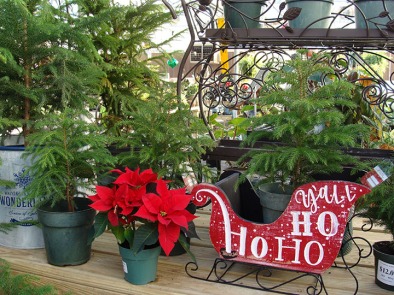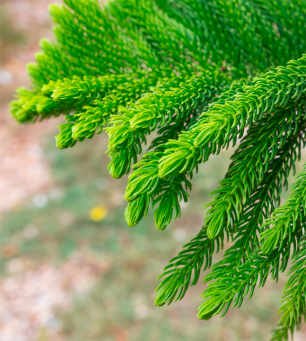 Norfolk Island Pine, Araucaria heterophylla, is a graceful, pine-like tree with a lacy, delicate appearance. It is popular during the holidays as an alternative to a cut or artificial Christmas tree but makes an elegant statement all year round. The common name is misleading because it is not an actual pine tree. It is a member of the genus Araucaria, in the family Araucariaceae, which also contains the hoop pine. There are several common names that may be used for this plant including Australian Pine, House Pine, Living Christmas Tree, Polynesian Pine, Star Pine and Triangle Tree. This plant is native to Norfolk Island and nearby South Pacific areas. Although it grows as a rather large tree in its native areas, it is a tropical plant and grows as a beautiful houseplant in our mid Missouri area. This evergreen, pine looking plant has saber-like leaves that turn inward in an overlapping herringbone pattern on tiered branches. It creates interest as a stand-alone plant or brings diversity among a group of plants. It is relatively slow growing as an indoor plant, but over years in favorable conditions it can reach heights of 6 to 9 feet. The Norfolk Island Pine is considered mildly toxic to humans and pets. It is best to place it out of reach of curious children and pets.
Norfolk Island Pine, Araucaria heterophylla, is a graceful, pine-like tree with a lacy, delicate appearance. It is popular during the holidays as an alternative to a cut or artificial Christmas tree but makes an elegant statement all year round. The common name is misleading because it is not an actual pine tree. It is a member of the genus Araucaria, in the family Araucariaceae, which also contains the hoop pine. There are several common names that may be used for this plant including Australian Pine, House Pine, Living Christmas Tree, Polynesian Pine, Star Pine and Triangle Tree. This plant is native to Norfolk Island and nearby South Pacific areas. Although it grows as a rather large tree in its native areas, it is a tropical plant and grows as a beautiful houseplant in our mid Missouri area. This evergreen, pine looking plant has saber-like leaves that turn inward in an overlapping herringbone pattern on tiered branches. It creates interest as a stand-alone plant or brings diversity among a group of plants. It is relatively slow growing as an indoor plant, but over years in favorable conditions it can reach heights of 6 to 9 feet. The Norfolk Island Pine is considered mildly toxic to humans and pets. It is best to place it out of reach of curious children and pets.
 Place your Norfolk Island pine in a bright area near a window. A spot that receives some direct sun is good. It will tolerate lower light situations. However, the less light it gets, the slower it will grow. Avoid very low-light situations. If it doesn’t get enough light (natural or artificial), it will become weak, spindly, and unattractive. If your Norfolk Island Pine seems like it is not growing or starts to get leggy, move it to an area that will receive more sunlight. Rotate the plant regularly, to promote even growth on all sides. Norfolk Island pine can go outside for the summer in a location that will offer full sun for the first part of the day but will offer shaded protection from the hot afternoon sunshine. Wait to put it outside until temperatures warm in spring and bring it in before they drop in fall – when the temperature will not drop lower than 65° F. overnight. Do not expose the plant to extreme changes in temperature. This plant prefers fertile, porous, sandy, peaty, slightly acidic, well-draining potting soil. A succulent potting mix will work well. Or, you can add peat moss and sand to a standard potting mix. In addition, use a deep potting container with good drainage holes. Norfolk Island pines, especially younger trees, have notoriously weak root systems. So, don’t hesitate to stake your tree up if it needs support.
Place your Norfolk Island pine in a bright area near a window. A spot that receives some direct sun is good. It will tolerate lower light situations. However, the less light it gets, the slower it will grow. Avoid very low-light situations. If it doesn’t get enough light (natural or artificial), it will become weak, spindly, and unattractive. If your Norfolk Island Pine seems like it is not growing or starts to get leggy, move it to an area that will receive more sunlight. Rotate the plant regularly, to promote even growth on all sides. Norfolk Island pine can go outside for the summer in a location that will offer full sun for the first part of the day but will offer shaded protection from the hot afternoon sunshine. Wait to put it outside until temperatures warm in spring and bring it in before they drop in fall – when the temperature will not drop lower than 65° F. overnight. Do not expose the plant to extreme changes in temperature. This plant prefers fertile, porous, sandy, peaty, slightly acidic, well-draining potting soil. A succulent potting mix will work well. Or, you can add peat moss and sand to a standard potting mix. In addition, use a deep potting container with good drainage holes. Norfolk Island pines, especially younger trees, have notoriously weak root systems. So, don’t hesitate to stake your tree up if it needs support.
Keep the soil moist, but not wet to avoid root rot. Check the soil weekly for dryness. If it is still moist at 1” down, wait a few days and check again until it is dry to at least 1” down. Water at that time and remove excess water from the saucer. You also do not want the soil to dry completely. If the plant stays too dry, the tips of its branches will turn brown and crispy. If you notice this happening, check the soil and water more frequently. Reduce watering in winter when growth slows due to short daylight conditions. Always check the soil as mentioned and adjust watering accordingly through the seasons. This is an acid-loving plant, preferring a pH in the 4.5-5.5 range. Fertilize Norfolk Island pine once or twice during spring and summer to keep it growing well. A weak solution of fertilizer made for acid loving plants will work well. Do not fertilize in fall or winter.
 Normal indoor home temperatures are fine for this plant but avoid placing them in drafty areas or near heating or cooling ducts. If the air is dry, increase the humidity with a humidifier, a pebble and water humidity tray or group plants together to increase the humidity within the grouping. You can also mist it regularly. Repot this plant in spring when the roots start to peek through the container’s bottom using the soil and container recommendation mentioned above. Norfolk Island pine can be pruned as needed. Remove lower branches that have died – a common occurrence when grown indoors. It is usually not recommended to trim the top of the tree, but if a potted tree gets too large for its space, cut off the central leader. New growth will not start on the ends of branches that have been cut. This will cause the tree to branch out from that point, and while the plant will lose the classic evergreen look, such trimming usually does not affect the health of the tree.
Normal indoor home temperatures are fine for this plant but avoid placing them in drafty areas or near heating or cooling ducts. If the air is dry, increase the humidity with a humidifier, a pebble and water humidity tray or group plants together to increase the humidity within the grouping. You can also mist it regularly. Repot this plant in spring when the roots start to peek through the container’s bottom using the soil and container recommendation mentioned above. Norfolk Island pine can be pruned as needed. Remove lower branches that have died – a common occurrence when grown indoors. It is usually not recommended to trim the top of the tree, but if a potted tree gets too large for its space, cut off the central leader. New growth will not start on the ends of branches that have been cut. This will cause the tree to branch out from that point, and while the plant will lose the classic evergreen look, such trimming usually does not affect the health of the tree.
Norfolk Island Pines are vulnerable to common pests including aphids, mealybugs, scale, mites, and whiteflies. Check the plant regularly for pests to identify an infestation as early as possible and treat it with a neem oil product or insecticidal soap as recommended on the label. Do not overwater to avoid fungal diseases. Keep light and moisture needs in mind as too little or too much can cause browning, yellowing or dropping needles. Extreme changes in temperature may also cause these issues.
